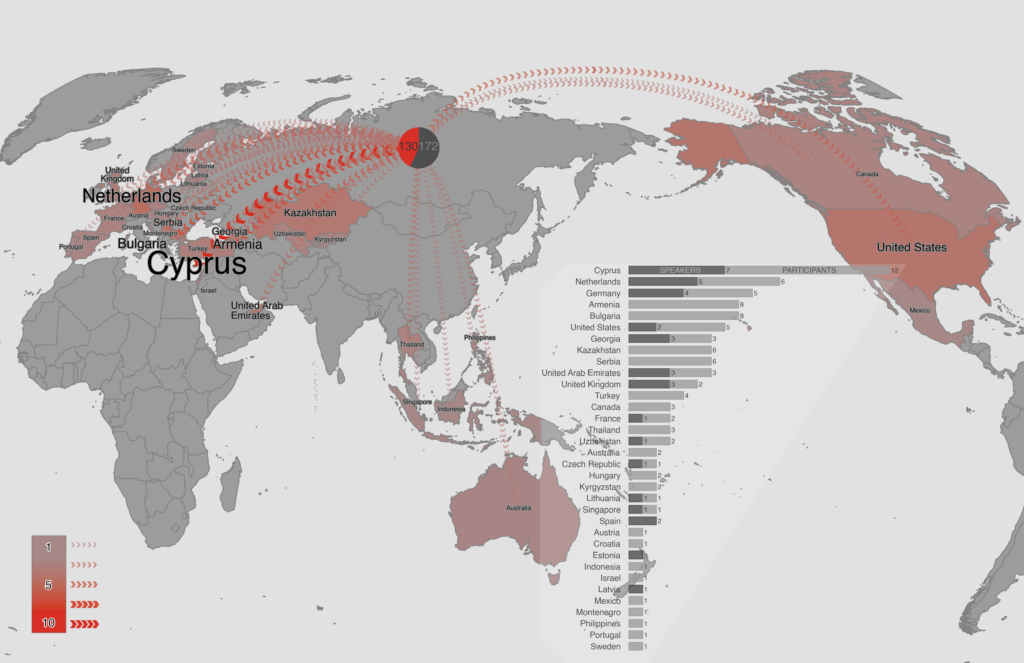Introduction
It is no secret that IT specialists are a valuable, scarce and strategic resource for the Russian government. The shortage of personnel was noted by many even before the full-scale invasion, and after the start of the war, IT specialists were the first to start massively leaving abroad. This process accelerated even more after the announcement of mobilization.
We analyzed the lists of participants of the largest Russian IT conference CodeFest, and, based on open sources, estimated the percentage of immigration among them.
The data for 2019 was taken as the base for the analysis, as it is the last pre-pandemic year in which the conference reached its largest size.
Partners
We can start with the partners and sponsors of the conference. Here is the list for 2019, both Russian and international companies are represented:
From this list, stopped operations in Russia:
- Intel – On April 5, they condemned the invasion of Ukraine and announced that they would cease operations in Russia. At the same time, they promised to support 1,200 Russian employees.
- PVS-Studio – currently registered in Kazakhstan.
- JetBrains – on March 11, decided to leave Russia and condemned the invasion. According to the Fontanka newspaper: “about 1,000 people worked in the company’s Russian subsidiaries, their annual turnover was 7.5 billion rubles. The largest of the legal entities, IntelliJ Labs LLC, paid 4.5 billion rubles in wages and more than 120 million rubles in taxes in 2021.”
- Kraftvaerk – the mention of the St. Petersburg office is missing from the website, which can be found in copies for January 2022. Mentioned in the same article on Fontanka.
- DINS – is also mentioned as a closed company. The website does not open, and all the latest news on the company pages in social media are cut after February 24.
- Wrike – announced their departure from Russia and suspension of Russian records service. The CodeFest website says about 9 offices in Russia in 2019, but now there is no mention of any presence in the country on the company’s official website. We may well consider that the company has stopped all activities in Russia.
Participants and Speakers
First of all, it is interesting to note the drop in the total number of participants. While in 2019, there were 2,875 offline participants, in 2022, the organizers are going to sell only 1,000 tickets:
Next, we analyzed the social media profiles of conference speakers in various categories, trying to determine from open sources whether they had moved abroad, and if so, where exactly they had moved to.
If the speaker already lived abroad or is obviously not a citizen of Russia, they are not taken into account in the statistics. The list of analyzed categories with speakers is as follows:
Speaker totals:
Total lived in Russia as of 2019: 80
Confirmed who has left so far: 39
Immigration percentage among speakers – 48%
Here is also a breakdown by category, without their names, so as not to disclose their personal data:
| Section | Emigrated / Total |
| Products | 1 / 5 |
| Backend | 9 / 15 |
| Teamlead | 4 / 6 |
| Projects | 1 / 5 |
| Frontend | 5 / 10 |
| QA | 5 / 11 |
| Data Science | 3 / 5 |
| Mobile | 8 / 13 |
| Future | 3 / 10 |
As for the participants themselves, we do not have enough time to analyze all 2875 names manually. Therefore, we wrote a script that collected all the data from the HTML page and automatically processed those profiles in which the LinkedIn social network was specified. Because an immigrated professional is more likely to enter updated information to find a job in a new place. Plus, it’s common practice to update your work page on LinkedIn when you change jobs.
There may be a complaint here that people with LinkedIn were likely already looking for work abroad and thinking about moving, and it’s hard to approximate them all. But we have no other more reliable and easy-to-automate ways to check a person’s current location, so we have to use what we have.
So, the results of the analysis:
A total of 293 out of 2875 participants were collected with the specified LinkedIn profile that was still active.
Of these, 22 who did not live in Russia in 2019 were excluded from the analysis.
Among them were found 2 people from Minsk, both obviously immigrated. Most likely, it is also politically motivated IT immigration, but in our statistics, we do not take them into account.
Summary of participants:
Total lived in Russia as of 2019: 271
Confirmed who has left so far: 95
Immigration percent among participants: 35%
Conclusions and summary
The conclusions are as follows:
- The most skilled and highly qualified specialists, who can find a job in any country, most often leave
- If we approximate the study to the entire country, then in the last years and especially after the invasion, the IT industry in Russia lost about a third of all employees, which is a huge staff shortage
We also made a map showing where the CodeFest speakers and participants went most often:

As for general statistics on IT professionals, we suggest reading an article by blogger Alexey Begin, who provides many graphs and data for the entire country.
